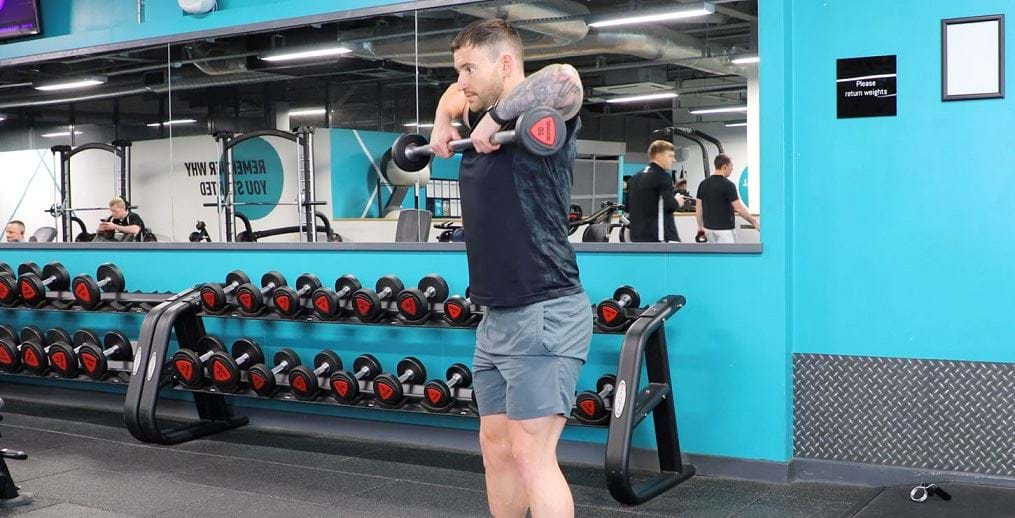Barbell Upright Row
What Is An Upright Row

The upright row is an exercise that involves pulling a load from below the waist up to shoulder weight. While this exercise has been branded as dangerous by some due to the internal rotation of the shoulders, it can actually be a great way to build strength and stability in the shoulders and improve pulling strength when performed with correct form. Strength built through this movement contributes well to daily activities such as carrying shopping and lifting objects overhead.
This exercise primarily targets the deltoids, trapezius, rhomboids, and biceps, and can be performed with barbells, dumbbells, and cable machines. Here we look at both barbell upright row variations; the upright row and the wide grip upright row.
Check out our other upright row variations: dumbbell upright row, cable upright row
Commonly Asked Questions On Upright Rows
The upright row works the shoulders and upper back, with the deltoids and traps the main drivers of movement. The rhomboids and biceps are also involved, and the core also needs to be engaged to ensure tension remains on the intended muscle groups.
The safety of the upright row has been heavily debated, with some arguing that it puts the shoulder joint at risk of impingement. For many, using a manageable load, reasonable range of motion, and correct form, heavily reduces this risk and ensures the exercise is safe. However, some people may find their shoulder joint anatomy means they are more at risk. Swapping to a wide grip can make this exercise more comfortable.
It is important to engage your core by tucking your pelvis towards your abs, as this helps to ensure the shoulders and back move the load. Row the barbell upwards to chest height, keeping your elbows below the shoulders. This avoids placing unnecessary strain on the shoulder joint.
Upright rows work both the shoulders, with a greater focus on the medial deltoids, and the upper back.
Upright Row Tips
It’s important to select a manageable load and opt for a higher rep range when performing the upright row. Using a heavy weight for low reps puts your shoulders at greater risk of impingement or injury. Choose a weight that allows you to reach at least 8 reps with good form and avoid training this exercise to failure.
If you find the upright row uncomfortable, changing variation can be helpful. For example, using an EZ bar can reduce wrist discomfort, while a wide grip upright row can help with shoulder discomfort.
The straight bar may also provide wrist discomfort for some performers therefore opting for an EZ bar is likely a helpful option to avoid this.
How To Do An Upright Row
Choose a preloaded barbell or load an Olympic barbell with plates, then grip the barbell using a pronated grip, so that your palms are facing downwards shoulder width apart.
Stand straight and pull your shoulders back, then engage your core by tucking your pelvis under and pulling your belly button towards the spine.
To begin the movement, lift the bar upwards, allowing your elbows to come out to the sides and keeping the barbell close to your body.
Raise the barbell until it is at mid chest height or shoulder height based on how comfortable the shoulders feel. Do not raise the elbows higher than the shoulders.
Revert the movement by slowly lowering barbell to the starting position.
How To Do A Wide Grip Upright Row
Using a preloaded barbell or load an Olympic barbell with plates, place your hands just wider than shoulder width apart and grip the bar using a pronated grip.
Stand tall and pull your shoulders back, then engage the core by tucking your pelvis under and pulling your belly button towards the spine.
To start the exercise, pull the bar upwards, allowing your elbows to come out to the sides and keeping the barbell close to your body.
Raise the barbell until it is at mid chest height or shoulder height based on how comfortable the shoulders feel.
Revert the movement by slowly lowering barbell to the starting position.
If you’re not sure if any of the above exercises are suitable for you, please consult your doctor before you start it. Need guidance on how to perform the exercise? Ask a personal trainer at your gym.